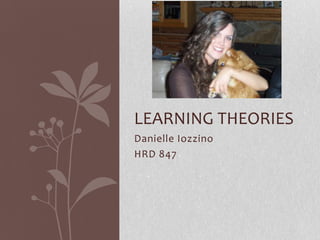
Learning Theories
- 1. Danielle Iozzino HRD 847 Learning Theories
- 3. Behaviorism: Founded by John Watson Behaviorists believe that behavior is directly observable. Behaviorism doesn’t focus on the processes of the mind. Connected with positive and negative reinforcement. Behavior can be manipulated and conditioned
- 5. An example of behaviorism in the workplace: A company was holding a contest to promote infection control. Each employee was given play money in dollar bills. If an employee saw another employee doing something positive to promote infection control, then he/she could give them a dollar. If an employee saw another employee practicing poor infection control, then he/she could take their dollar away. In the end, the employee with the most play money was rewarded with a cash prize.
- 8. Our mind groups things in ways as simple as possible.
- 9. Example: We group the Olympic symbol as 5 circles.
- 10. The second law is Similarity.
- 11. Similar things are grouped together.
- 12. Example: We group similar shapes and colors together.
- 13. The third law is Proximity or Nearness.
- 15. Things that function together are grouped as a unit.
- 16. Example: Birds fly together, and we group them as one unit.
- 17. The fifth law is Familiarity.
- 18. Shapes are more likely to form together if they look familiar to us, or if they have meaning..
- 19. Example: A triangle above a square can be perceived as a house.Gestalt Psychology’s motto is that the whole is greater than the sum of it’s parts. This type of approach is important for teamwork, and is often reflected in the workplace.
- 20. Constructivism: Constructivists believe that one’s past experiences influence the person’s view of the world. In order to learn, one must adjust expectations in order to allow for new experiences. They believe that learning should be hands on, in order to allow openness to new experiences while problem solving. A manager can help the employee learn by encouraging more interaction, and asking for feedback.
- 22. We then have to change our beliefs in order to perceive this new information.